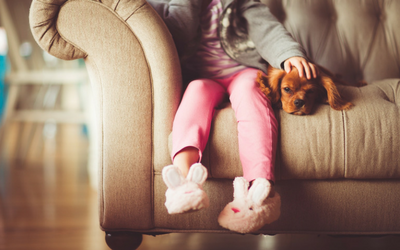
We see them on the news frequently: tornados, earthquakes, hurricanes, floods, fires, blizzards, and more. They might even have affected your life in a scary and meaningful way. Natural disasters are dangerous events that happen throughout the world, probably more frequently than we would like, and impact animals as well as humans. Sometimes the effect these natural disasters can have on animals are overlooked, but it is important to remember that their lives can be devastated as easily and thoroughly as human lives can be in the event of a natural disaster. September is Natural Disaster Preparedness Month, which serves as a reminder that we should all prepare, now, for emergencies that could affect our families and pets, and not be caught unprepared in the face of a disaster.
It is important to be prepared for natural and any other type of disaster or emergency situation, and that includes taking your pets and their needs into account when creating emergency plans and supplies. Be prepared for the loss of services such as power, gas, and water, and make sure you have alternate sources of basic necessities like water and fuel for heat for everyone in your family.
Put together emergency supply kits for everyone in your family, pets included. Animal emergency kits should be stored in easy to access places, with the rest of the emergency supplies and kits for the family. Some things you should include in a pet emergency supply kit are:
- A crate or carrier for each of your pets, that is large enough to hold their food and water dishes, with enough room for them to still stand, turn around and lie down in. It can be a good idea to label the crate with your contact information, your pet’s information, and your vet’s contact information.
- Collar or harness and leash for each animal
- Non- spill food and water dishes.
- At least two weeks’ worth of food per animal, with dry food in airtight containers. Wet, canned food is also good to have, as wet food helps to provide some moisture for your pet, and will make them less thirsty. Remember to include a manual can opener, spoon for serving, and don’t forget a few treats as well!
- Two weeks’ worth of water per animal, bottled. A large dog needs about a gallon of water a day, smaller animals less so, but make sure to have a generous supply for everyone.
- Familiar comfort items such as blankets and toys.
- Plastic bags for waste disposal, along with newspapers, paper towels, and bleach for cleanup and sanitizing. An extra litter box, litter, and scoop if you have cats.
In a waterproof bag, be sure to have the following as well:
- Copies of all your pet’s veterinarian documents, including proof of ownership and microchip numbers, pictures of yourself with your pets, vaccination and medical records, and contact information for your vet.
- An ample supply of any medication and preventative medications with dosage instructions.
- An instructions page outlining feeding routines, administering any medications, medical issues, behavioral issues, and any other information specific to your pets.
- First aid kit.
Make sure all your pets are wearing identification tags that are up to date, and consider having them microchipped and registered, to give you the best chance of being reunited with your pets, should you be separated during an emergency.
Have a disaster plan in place and consider developing an emergency contact list- in the event that you are away from home when an emergency occurs, a trusted neighbor, nearby family member or friend should have a key to your home, know your pets well, and know where to find their emergency kit. A plan should be made to safely evacuate your pets in the event of an emergency. You can also place stickers on doors and windows to notify rescue crews like fire and police that animals are in the house and need to be evacuated.
Always, always take your animals with you. If a situation if unsafe for you, it is unsafe for your pets. Sometimes when people are told to leave their homes, thinking it will only be for a short time, they neglect to bring their animals, believing they will be safer at home. However, in the event of a natural disaster, conditions can quickly worsen and prevent you from getting back home to your animals, putting your animals in greater danger or leaving them without care and necessities for long periods of time.
